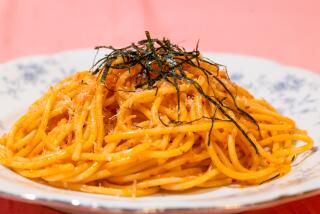It’s artichoke time in Italy -- and here
I love this picture of Puglian chef Silvestro Silvestori trimming artichokes because it so nicely illustrates the kind of zen calm the activity induces – and the almost unbelievable amount of waste. I don’t think I’ve ever cleaned a batch of artichokes without pausing for a moment to wonder how somebody somewhere discovered that these were good to eat. Actually, it’s even weirder than that, because artichokes are a domesticated version of cardoon – meaning that some unknown farmer probably had to work for years to develop spiky flowerheads that were that size.
As Silvestori puts it: “Today though as I trimmed, it occurred to me that ‘appreciation’ and ‘anticipation’ are also ingredients in the recipe, as real as oil or salt.”
No matter, I’ve got a thing for artichokes and every spring and fall, when the harvests are at their best, I go through pounds at a time (thank you Trader Joe’s and long may your association continue with Ocean Mist – the growers’ cooperative that produces by far the most artichokes in the U.S.).
I still trim artichokes the way I learned many years ago from a friend who had been a line cook at Commander’s Palace in New Orleans, where they go through cases of artichoke hearts every brunch. It’s a lot harder to describe than it is to do, so don’t panic:
1. Fill a bowl with cool water and add the juice of 1 lemon. Hold an artichoke in one hand with the stem facing toward you and the tip facing away. Slowly turn the artichoke against the sharp edge of a knife while making an abbreviated sawing motion, cutting the outer leaves at the base. (It’s easier to control if you use the base of the knife rather than the tip.) When you can discern the natural cone shape of the artichoke, adjust the knife to follow it.
2. Keep trimming until you’ve cut away enough of the tough leaves so you can see only light green at the bases. Cut away about the top half-inch of the artichoke tip and dip the artichoke into the lemon water so the cut surfaces don’t get discolored.
3. With a paring knife, trim away the very tip of the stem, then peel the stem and base of the artichoke, going from the tip to where the base meets the leaves. You’ll have to do this at least five or six times to make it all the way around the artichoke. When you’re done, there should be no dark green tough spots left, only pale green and ivory.
4. Cut each artichoke into lengthwise quarters, and if there is a fuzzy choke inside, cut just below the choke to the very base of the leaves and the choke will pop off, leaving a clean heart below. Place the artichoke in the lemon water and go on to the next artichoke.
My favorite way to cook them is braising, or “glazing”: Put the trimmed hearts in a saute pan with a good glug of olive oil and just enough water to cover the bottom of the pan. Cover and cook over medium heat until the artichokes are tender (it’ll take about 10 to 15 minutes depending on the size and freshness of the artichokes).
Add whatever flavorings you want – minced garlic, at a minimum, but you can go kind of crazy if you want with orange zest, black olives, you name it – and increase the heat to high. Cook, stirring constantly, until the water has evaporated, leaving behind a light sauce made of olive oil and artichoke juices.
ALSO:
California wine grape harvest a record
Hey Girl: Ryan Gosling here; I’ve got chocolate
Brooke Williamson makes the “Top Chef” showdown
More to Read
Eat your way across L.A.
Get our weekly Tasting Notes newsletter for reviews, news and more.
You may occasionally receive promotional content from the Los Angeles Times.











